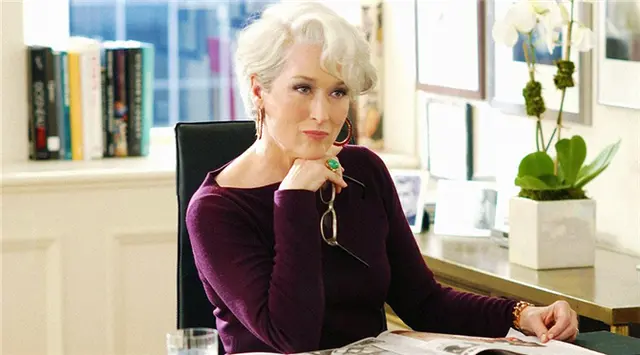The Devil Wears Prada rings in its 10th anniversary this week, and in celebration, star Meryl Streep has granted a few interviews—explaining why she was eager to play the icy fashion editor famously inspired by Vogue’s Anna Wintour. Upon reading the script, Streep tells indieWire that she remembers thinking, “Nobody’s seen this before and the girls are going to like this!” Streep continues, “I didn’t have any doubt about it. It’s very rare, and you know it when it’s happening.”
The book, written by Wintour’s former assistant Lauren Weisberger, was a smash success when it was released in 2003. It spent a solid six months on the New York Times bestseller list; millions of readers identified with the book’s central character, Andy, who finds herself at the mercy of a fashion magazine’s sadistic first-in-command. But when Streep, a staunch feminist who has spoken out all over the world in her fight for equality, read the novel, she seems to have immediately sympathized with Miranda Priestly—Andy’s boss and antagonist, who is portrayed as the story’s emotionless villain.
The book was written about Anna Wintour from the point of view of someone who worked for her. It’s a version of her, not necessarily accurate or whatever, a piece of fun fiction, “chick lit.” Embedded in it. . .is what the perceived deficits are of women in a leadership position. Chief among them is to expect women to be endlessly empathetic, a sense of employees’ discomfiture that she doesn’t give a shit, all the things that they would not ask of a male boss.
With certain professions you put aside your feeling gene, your tendency to feel the other’s pain, in order to be efficient and get the day’s work done. A certain amount of work has to be achieved during the day, you want a direct order and follow through on that order. There’s that expectation that hurts women more in leadership than it does men. I’ve seen that in so many different places.
Like The Devil Wears Prada’s readers, Streep found it hard to separate Miranda from Anna. And Weisberger’s critical portrayal of the magazine’s editor bothered her.
“It interested me that Anna Wintour was expected to be smilier, nicer, sweeter,” Streep continues. “I thought, ‘Well, hell, what is her job? What does she have to do? What are her deadlines? What do we have very little time for, even though the dress and heels have to have the outward accoutrements of being appealing, womanly?’”
In her effort to make the Miranda character more sympathetic, Streep insisted on including the “cerulean monologue” in the film—during which her character explains why the fashion industry is more than a frivolous interest.
“The most interesting piece to me was the responsibility lying on the shoulders of a woman who was the head of a global brand and fashion empire,” Streep explains. “In business terms, I wanted to know what that was like. We punched out the beginnings of that cerulean blue sweater scene. That would be interesting to people—not just, ‘your boss is a bitch,’ but, ‘What are the pressures and the responsibility of what it is to be a boss?’”
Speaking to V.F. Hollywood last month, The Devil Wears Prada screenwriter Aline Brosh McKenna confirmed that Streep “really stressed the lack of vanity about Miranda—that Miranda was really focused on her work and was under certain pressures, as a woman in that position of power.”
As for that famous “cerulean” monologue, McKenna explained why the historical details Miranda rattles off had to be fictional.
“It was funny, because somebody wrote an article saying, ‘They didn’t show this color on this day,’” McKenna told us. “It really made me giggly, because I couldn’t use real examples. Because, first of all, we had to pick a color [for Andy’s ’lumpy sweater’] that would work onscreen, and blue was going to be the best color to use, so we kind of worked from there.”
(VANITY FAIR)
 简体中文
简体中文



